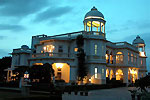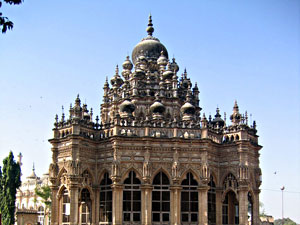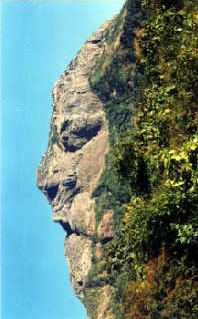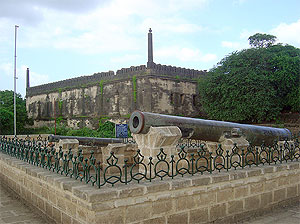|
|
| |
|
Gujarat Tours |
|
|
|
|
| |
|
|
| |
|
|
| |
|
|
| |
|
|
| |
|
|
| |
|
Gujarat Hotels |
|
|
 |
|
|
|
|
|
|
|
|
|
|
|
|
Junagadh Attractions |
|
|
|
|
|
|
|
Various tourist
attractions in Junagadh are the Mahabat Maqbara, Durbar Hall
Museum, Narsinh Mehta's Choro, Mount Girnar, Upperkot Fort,
Jama Masjid and Ashoka's Rock Edicts. |
|
|
|
Mahabat
Maqbara
Mahabat Maqbara is a stunning mausoleum of one of the Nawabs of Junagadh. This mausoleum is one of the
Gujarat's most glorious examples of Indo-Islamic
architecture. This mausoleum was built in 1892 and
topped with silver doors and intricate architecture,
including minarets encircled by spiraling stairways.
This mosque is generally locked.
Narsinh Mehta's
Choro
Narsinh Mehta's Choro is a great revered place where
the great poet and saint Narsinh Mehta used to hold
his assemblies, religious discourses and Bhajans in
the 15th century. There is a small temple of Gopinath
|
 |
|
|
and the idol of Shri
Damodar Raiji and Narsinh Mehta. Narsinh Mehta was one of
the great poets of India. He was a great devotee of Lord
Krishna and a scholar, philosopher and a social reformer.
Durbar Hall Museum
Durbar Hall Museum houses a large collection of silver
chains, chandeliers, thrones, palanquins, weapons and armour
from the days of the Nawabs. There is also a portrait
gallery of the Nawabs. This museum was once the hall where
the Nawabs held their Darbars (assemblies). |
|
|
|
Mount Girnar
Mount Girnar is one of the hill in Ahmedabad which is
most sacred to the Jain community. This hill rises to
a height of more than 600 m, a climb marked by 10,000
stone-steps. On this hill various Hindu and five Jain
temples are located. There is a group of 16 Jain
temples on the hill. This sacred hill is visited by
millions of Hindus and Jains. The Amba Mata temple is
situated on the top of the hill. The newly weds came
here and worship the Amba Mata in order to ensure a
happy marriage. One of the largest and the oldest Jain
temple, dedicated to the Neminath, the 22nd Jain
Tirthankar and the Mallinath, the 19th Jain Tirthankar
are situated just below the Amba Mata temple. There is
an image of Neminath in each of the courtyard
colonnade’s 70 cells. This temple was built in the
12th century. The corbelled domes, maidens and flying
figures as decoration are typical of the Solanki
period. A popular fair is also held here during the
Kartika Purnima festival in November - December.
Besides this the Bhavnath temple of Hindus is also
located on this hill. The Bhavnath temple is dedicated
to the Lord Shiva. The Mahashivaratri fair held here
is attended by Nagasadhus and pilgrims from all over
India. When a traveler to Gujarat, Joss Graham,
climbed up the hill for the festival of Shivaratri,
|
 |
|
|
he slept there overnight.
He woke up on hearing the praying murmurs of the great mass
of devotees, about 100,000 of them in their communities and
tribal groups. There is also the temple of Samprati Raja, a
fine example of the later period and the Melak Vasahi
temple.
Damodar Kund
Damodar Kund is a holy water reservoir that marks the ascent
to the Girnar temples. It is surrounded by a well-built ghat.
It is believed that here Lord Krishna placed a flower
garland around the neck of the great poet and saint Narsinh
Mehta.
Ashoka's Rock Edicts
Ashoka's Rock Edicts are located on the route to the Mount
Girnar hill. This rock edict is a huge boulder that is
housed in a small roadside building. On the rock edicts the
fourteen Edicts of Emperor Ashoka are inscribed. The
inscriptions carry Brahmi script in Pali language and
belongs to 250 BC. On the same rock the inscriptions in the
Sanskrit language are also inscribed. The Ashoka's Rock
Edicts incorporate moral lectures. The emperor Ashoka began
the stone written history of Junagadh on this boulder. His
14 edicts in Pali states that he, the Beloved of the Gods,
looks after all his subjects.
Jama Masjid
The Jama Masjid is built inside the Upperkot Fort in
Junagadh. This mosque was built from a demolished Hindu
temple and has an interior filled with columns.
|
|
|
|
Upperkot Fort
Upperkot Fort, also known as the Upper Fort is located
on the eastern side of Junagadh. This fort was built
in 319 BC by Chandragupta Maurya, though it has been
rebuilt and extended many times over the centuries.
During the period, various enemies tried to capture
the fort but it can not be captured by any of the king
for a longer time. The king of Anhilwad Patan once
attacked Junagadh to win the Raja’s wife. He won the
battle only because one of the Raja’s ministers
betrayed him, but he could not win the wife of the
Raja as she committed Sati. This fort was the
stronghold of the Mauryans and Gupta empire and as
such has survived for 16 |
 |
|
|
sieges in the last 1000
years due to its strategic location and difficult access.
The entrance to the fort is formed by an ornate triple
gateway. This gateway is like the Hindu Toran, leading to
flat land dotted with various archeological sites. In some
of the places, the walls of this fort are as high as 70
feet. The fort has many interesting exhibits like the canon
guns placed on the western wall and believed to have been
cast in Egypt. The two step wells (Adi-Kadi Vav and Navghan
Kuvo), a tomb, mosque and some ancient Buddhist caves
belonging to 200 BC to 200 AD are located within the fort
premises. Now only, some of the ruins of the buildings, Jama
Masjid and the Buddhist caves are located within the fort
premises. Adi-Kadi Vav and Navghan Kuvo are the two step
wells which are located within the fort. These wells were
built by the Chudasama Rajputs and are the unique water
structures among the various step wells of Gujarat. Both
these wells served as the main sources of drinking water for
years and were the essential part of the basic need of the
fort. The Adi-Kadi Vav has a long flight of 120 steps which
lead to the water and was built in the 15th century. While
the Navghan Kuvo of 1026 AD is built from soft rock and is
52 meter deep, reached by a circular staircase winding
around the shaft. The Buddhist caves are fine examples of
rock cut architecture. These caves have ornamented pillars,
carved entrances, water cisterns, chaitya hall, monastic
cells for meditation and chaitya windows. |
|